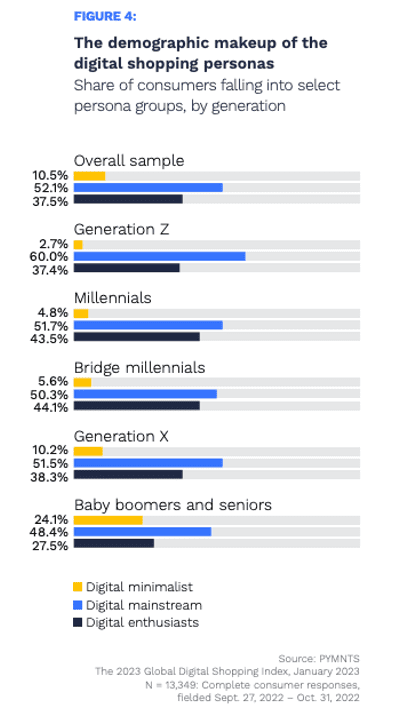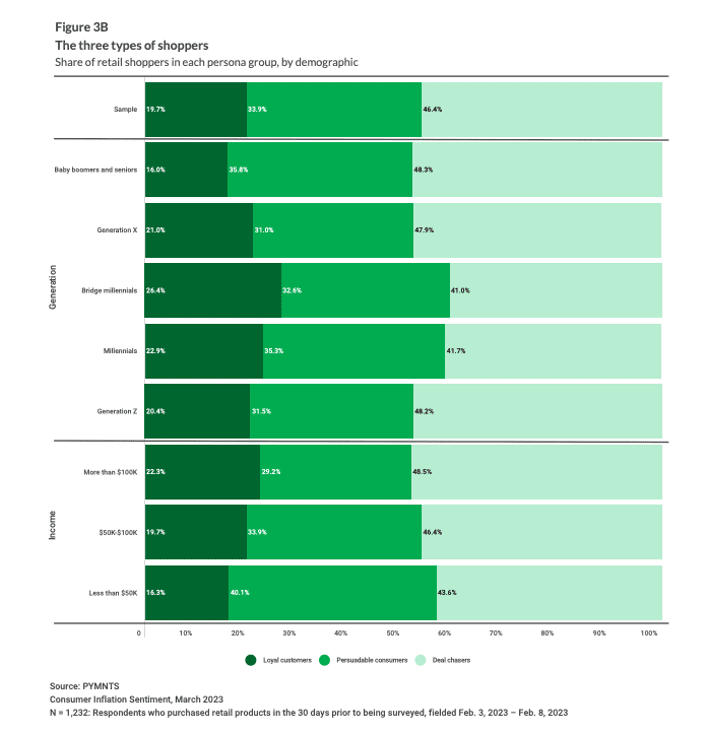
As the business world looks for new ways to court millennials and Gen Z, baby boomers get somewhat overlooked, and that’s a missed opportunity given their economic profile.

The view of baby boomers — born between 1946 and 1964 — is changing as the image of this demographic group as tech-averse and uninvolved in the shift to digital is being redefined.
For example, “The 2023 Global Digital Shopping Index,” a PYMNTS and Cybersource collaboration that examines consumers’ digital shopping behaviors and payment preferences across six major world economies, finds that nearly half (48.4%) of boomers in nations studied fall into the category we call “digital mainstream.”
That’s just a few points lower than Gen X and Millennial consumers who are among the most digitally active shoppers and spenders, and our data finds other reasons that brands should bake more boomer into their marketing and products.
According to PYMNTS’ March report “Consumer Inflation Sentiment: The False Appeal of Deal-Chasing Consumers,” over 35% of baby boomers fall into the “persuadables” category of shoppers, meaning that while they won’t pass up a great deal regardless of the brand or retailer, they have preferences that brands can use to create appealing offers more likely to convert.
As PYMNTS’ Karen Webster wrote of persuadables in March, “the circle of retailers they shop is small. But what makes these consumers persuadable is their loyalty to the products they like to buy, where they buy them, and how buying them fits into their overall spend.”
While nearly half (48.3%) of boomers and seniors describe themselves as deal chasers, the fact that millions of boomers are financially comfortable — and in many cases retired or semi-retired — means they are more interested in travel, retail and entertainment options that don’t break the bank but offer bang for the buck.

This is seen in segments like beauty and wellness products.
As PYMNTS recently reported, “The beauty industry is currently placing a renewed emphasis on older women as a means of capturing the attention of one of the wealthiest cohorts of consumers. Brands such as L’Oréal have enlisted several notable industry figures, including Helen Mirren (77 years old), Jane Fonda (85 years old), Viola Davis (57 years old), and Maye Musk (74 years old), who became CoverGirl’s oldest model in 2017. In addition, e.l.f. Cosmetics selected Jennifer Coolidge as an influencer and featured her in its 2023 Super Bowl commercial. These moves represent a concerted effort by the industry to increase consumer spending among older women.”
Additionally, brands that cater to boomers are fishing where the real money is, as this group controls more wealth than any other demographic and quietly dominates key areas of spending.
As the Visual Capitalist reported, “Controlling almost 70% of disposable income in the U.S., Baby Boomers are arguably the most influential of all consumer groups,” adding that “this generation dominates almost 50% of consumer-packaged goods (CPG) sales in the U.S.—which likely explains why the rest of their top brands are more traditional household names, such as Macy’s, Hershey’s, and Kellogg’s. It is also clear from the ranking that this group values brands with nostalgic qualities, as well as the ability to provide them with moments of indulgence.”